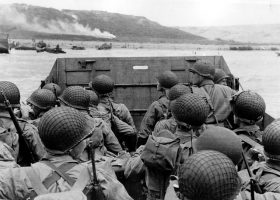War seemed bound to happen. Japan struck first, plunging into Chinese Manchuria. Next Italy struck at Ethiopia. Germany, under the leadership of Adolf Hitler, fueled the most fear. Germany had impressive power. And Europeans and Americans both remembered how strong the German army was in World War I. By the end of the decade, the nations surrounding Germany began to fall like dominoes. In 1939, Hitler seized Austria, then Czechoslovakia. As Hitler set his sights on Poland, the world prepared for another great conflict.
Meanwhile, Americans tried to stay isolated. The U.S. had created a series of Neutrality Acts in order to avoid the traps that led them into World War I. Poll after poll showed the American public did not want the country to become involved in international disputes. "Isolationist" clubs spread across the land.
Eventually though, Great Britain became the last defender of freedom standing against a Nazi-controlled Europe. Americans reluctantly began to act. Led by President Franklin D. Roosevelt, the United States used its industrial power to start supporting the Allies - the democratic countries fighting against the fascist "Axis" countries of Germany, Japan, and Italy.
In the end, it was Japan that brought the United States into the war. The United States was the only nation standing against complete Japanese control of the Pacific Ocean. One way it did this was through economic sanctions against Japan. Japan was so angry that in 1941 it launched a brutal surprise attack against American naval bases at Pearl Harbor in Hawaii. After the attack, the United States finally entered the Second World War.
The government quickly began to encourage the American people to support the war effort. Factories had to produce lots of weapons, food, uniforms, and other materials for soldiers. There were major operations in both the Atlantic and Pacific "theatres," which meant that American industries literally fueled two wars at the same time. The war effort produced many social and economic consequences. African Americans moved from the rural South to the industrial North for jobs faster than ever before. New opportunities opened for women who were encouraged to work in factories and hospitals to support the war. The economy got a huge boost from all of this wartime production. Because of the increased employment opportunities, Americans who had been struggling since the Great Depression finally enjoyed a high standard of living again.
But the war effort also had a darker side. Civil rights were compromised. After Pearl Harbor, Americans feared potential Japanese spies or supporters. As a result of this fear, and anti-Japanese racism, over 110,000 Japanese Americans were forced from their homes and sent to distant relocation camps. These camps had poor living conditions. Japanese Americans would live in these camps for over four years, even after Americans liberated Jews from Nazi concentration camps.
In both Europe and Asia, the Axis powers had established a firm foothold prior to American entry into the conflict. However, slowly but surely, the Allies closed in on Nazi Germany. Big battles at El Alamein and Stalingrad helped the Allies weaken the Germans. In 1943, after the Allies invaded Sicily and bombed Rome, Italy quit the Axis. First Italy's fascist Prime Minister was fired; then the Italian King arrested him and signed a secret agreement with the Allies. The Allies were able to land on Italy's southern shores without any fighting and head North, forcing Germans in Italy to retreat. Then, in 1944, the Allies landed successfully on the French shores of Normandy to begin an invasion of German-occupied France. it was only a matter of time before Allies smashed the Nazi machine.
Failures marked the early war in the Pacific theatre. Things looked bad when Japan captured the Philippines from the U.S. in 1942. But then the U.S. damaged Japan's naval fleet of ships at the Midway Islands just six months after the attack on Pearl Harbor. After that, Americans "island hopped" their way to Japan. Island hopping let Americans strategically avoid areas the Japanese had heavily defended. Still, some of the islands Americans did take were sites of bloody battles. It took a long time for the U.S. to force Japan to retreat. Americans took back the Philippines in 1944, then closed in on Japan by invading Iwo Jima and Okinawa in early 1945.
New technologies emerged during the war as well. Radar helped the British locate incoming German planes, and sonar made it much easier to find submarines. Germans developed rockets that could travel great distances, creating a new era of long-range warfare. But no weapon compared in destructive power to the atomic bomb. The nuclear weapon was developed after a massive, secret research project spearheaded by the United States government. World War II did not officially end for America until President Harry S. Truman dropped two atomic bombs on Japan, at Hiroshima and Nagasaki, in August of 1945.
World War II was fought over differences left unresolved after World War I. Over 400,000 Americans were killed in four years of involvement. The only deadlier war for Americans was the Civil War. The Nazis murdered over six million Jews in the Holocaust, and killed over five million other "enemies" of Germany. Over 20 million Soviets died, many of them civilians, devastating Soviet communities. Because other Allied countries experienced far fewer casualties, many Soviets lost trust in their western Allies.
After much bloodshed and sacrifice, the Axis powers were defeated. But the Grand Alliance that won the war, of the United States, Great Britain, and the Soviet Union, did not last long. Soon the globe was involved in a 45-year struggle between America and the Soviet Union known as the Cold War





